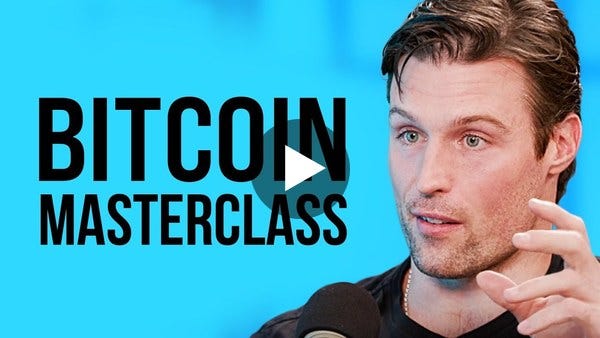What is money? | Just Reflections - Issue #23
Hi friends,
Welcome back. First, some admin. Last week, some subscribers experienced an issue where the newsletter got delivered to their spam/junk folders, meaning they didn’t see the newsletter. If you are one of these, I apologize. Please check in there for last week’s issue and add us to your contacts so that it doesn’t happen again. On most email clients, you can click the three dots context menu and find the option that says ‘Add to contacts’ or something similar.
I’ll monitor the analytics this week to make sure that people receive the newsletter. If there are any challenges, I might have to email everyone with instructions on how to rectify things.
With that out of the way, let’s get it.

This is part 1 of a series on cryptocurrencies:
I promised myself to learn about blockchain technologies over the holidays. I am particularly interested in blockchain software development. While blockchain technology applies to many more things than cryptocurrencies, for many people, the moment you say blockchain, they think about cryptocurrencies. Bitcoin in particular.
In the next few weeks, I’d like to share some of what I’ve learned. Hopefully, that will clarify the distinction between the blockchain and cryptocurrencies and help you understand the problems they are trying to solve and the claims they are making. After you are more informed about this stuff, you’ll be more equipped to figure out whether you should care.
Our first stop today is a look at what exactly is money.
A brief history of money
Bartering
The reality of life is that we don’t have all the things we want, other people have things we want and we have things that other people want. This perfectly sets the stage for bartering.
Bartering is direct exchange; trading something you have that the other person wants for something they have that you want. You’ve probably bartered in the past yourself, trading your Harry Potter book for a video game disc or a sandwich for a banana at school during break time.
While bartering is very simple, it has the challenge that sometimes you may want something from someone who wants something that you don’t have. You have goats. You want a cow, but your friend who has a cow wants sheep. Your best recourse to make everyone happy is to find a third person who has sheep and wants goats, then coordinate a three-way trade.
A solution to bartering’s requirement for coordination between multiple parties is money.
Money
Money is something that is used as a medium of exchange so that we don’t have to exchange goods or services directly. It is a call option on everything which means it is the most exchangeable good.
With money, we can make a trade with someone even if they don’t want the stuff that we have. We pay them with money instead of giving them the goods directly. The premise here is that, if I believe I can use your money to get something I want in the future, I’m happy to receive it now for something you want from me. So the money is valuable to me because of what it can do for me in the future.
Note that when I accept one dollar for your apple, in most cases, I’m not saying the apple is worth exactly one dollar. Instead, I’m assuming that it is worth less than that so that I profit from the exchange. Similarly, at that point, you believe that your need for an apple is greater than the value of that one dollar. Another thing to note is that when many of these trades with money are happening and this money is generally accepted (or is in circulation), we call it currency. So currency is just money in circulation.
Commodity money
Early versions of money weren’t what we know money to be today. They were goods that had inherent value and could meet basic needs independent of their status as a currency. For example, barley has been used to facilitate trading and if you wanted to, you could also eat it (so you could literally ‘eat money’ ba dum tss 😁). Money like this, which is valuable because it is made of a good that has inherent value, is called commodity money.
An additional quality of commodity money is that its units are mutually interchangeable. The technical way to say this is that commodities are fungible — keep this ‘fungible’ term in mind, it will be useful if we ever talk about NFT’s. The example of barley that I gave is commodity money because any batch of barley is essentially indistinguishable from any other batch. Your one kilogram of barley is equal to my one kilogram of barley. Tennis shoes, on the other hand, are not a commodity, since people could pay much more for certain brands of tennis shoes than others.
Commodity money, like barley, is nice because we can trust that most people will find it valuable because of its inherent value. However, it has some downsides. One, it is bulky and is therefore inconvenient to move around in large quantities. And two, it is difficult to store in large quantities because it needs a lot of storage and can rot. So you can’t exactly save your barley for many years for a big purchase without risking all of it rotting.
Commodity backed money
A solution to this problem of inconvenience and degradation is using a commodity that is convenient to handle and move around whether or not it has inherent value. For many years, precious metals like gold and silver were used to make coins for currency because they have several characteristics that make them convenient as commodity money. They don’t degrade over time. They are common enough that it’s possible to find more but are rare enough that it takes a lot of work to find more (but more can be found. Keep this in mind, it will be important in future lessons). And the amounts that most people would have are easy to carry around. The fact that precious metals don’t meet a basic need to justify them as having inherent value didn’t dissuade people from assigning them value.
Another solution is entrusting all our real commodities with one trustworthy central authority and then using a representation of the commodity for trading instead of the commodity itself. So we give the village chief all our barley and she gives everyone one barley note for every one kilogram of barley they give. We can then freely trade with barley notes, exchanging them to our heart’s content. If at any point someone decides that they’d rather have their barley, they can go to the chief and submit the barley notes they have and be given barley equivalent to the notes they have. Because commodity units are mutually indistinguishable, you don’t need to get back the exact barley grains you submitted, just an amount equivalent to the number of barley notes you have.
This makes our money system more convenient but requires us to trust that central authority. We need to trust that the village chief will store all our barley safely. She will accurately account for how much barley each person put in storage and she will not eat some of our barley and claim that it rotted.
This is a concept of money that has been fully embraced in most parts of the world in modern times. There is only a small fraction of trade that still happens via bartering or commodity money these days. However, we are still not at the exact concept of money we use today.
Fiat money,
The money we use today doesn’t have inherent value, the material it’s made of doesn’t meet any basic need (you might burn it and get 23 seconds of warmth). It is also not backed by a monetary commodity like gold stored in some vault somewhere.
People exchange it for valuable goods because it is backed by governments. This kind of money is called fiat money. The word ‘fiat’ means a formal authorization or proposition or a decree. So our current money has value because our governments say it has value and we trust them. It is value-by-decree. There are nuances to this of course, but in general, this is our monetary system today.
Assigning value just because the government says so may sound a little strange but it’s easy to trust that the monetary system will keep working and that others will continue to honour the value of money because a large, powerful entity says that it will enforce this system. And it’s not the only thing that functions because we trust the government. I’m sure you can think of examples of other things.
This is where I want to stop for this issue, but before I wrap up, let’s briefly touch on an additional layer to fiat money that’s in use today; credit. If you think fiat money is a little crazy, wait till you hear about credit.
Credit
When making a trade, you don’t even need to trade in a commodity or fiat money. You also have the option to trade with promises. The promise that you’ll pay back later. This system is called credit.
Credit takes the concept of trust a level further because, for it to work, you’re not even trusting governments anymore. You trust that the person you’re transacting with will fulfil their promise to pay later. Of course, for most everyday uses of formal credit, the risk is transferred to the credit card company. When someone uses a credit card to pay you, you receive the money immediately. At that moment, they are essentially making a promise to the credit card company that they will pay later.
Closing thoughts
As a society, we’ve learned to live with the risks associated with trusting institutions and government decrees on the value of our money because, mostly, they’ve done a good job. However, as history shows us, the government is not always trustworthy and sometimes, when it goes wrong, it can go terribly wrong. But is there a better way?
Cryptocurrencies offer another system that’s different from what the monetary systems we’ve used so far. They accomplish a monetary system that doesn’t depend on trust in any central authority or the people we’re transacting with. It requires trust in mathematics and algorithms. We’ll break this down in a future issue, so keep an eye out for that.
What do you think of these ideas? Are there things you didn’t know before reading this? Did I get something wrong? Whatever your thoughts, please hit reply and let me know. I’d love to chat about it.
That’s all I have for you this week. If you like the newsletter, consider sharing it with others on Twitter, WhatsApp or Facebook. Hit the thumbs up or thumbs down below to let me know what you think.
I hope I’ve given you something to think about this week and I wish you ever-increasing curiosity.
Until next week.
BK
PS: If you’d like to go ahead of me and learn some on this stuff and more. I found this 2-hour podcast that talks about some of this stuff in a simple and interesting way.

The Philosophy of Bitcoin and How it Could Change the World As We Know It | Robert Breedlove
Impactful ideas that challenged my thinking.
I have a lot of interests so I'm always learning all kinds of things, some of which really challenge my thinking. In the Just Reflections newsletter, I'll be sharing with you a summary of the ideas that challenged my thinking recently and hopefully they will challenge yours too and we grow together.
In order to unsubscribe, click here.
If you were forwarded this newsletter and you like it, you can subscribe here.
Powered by Revue

